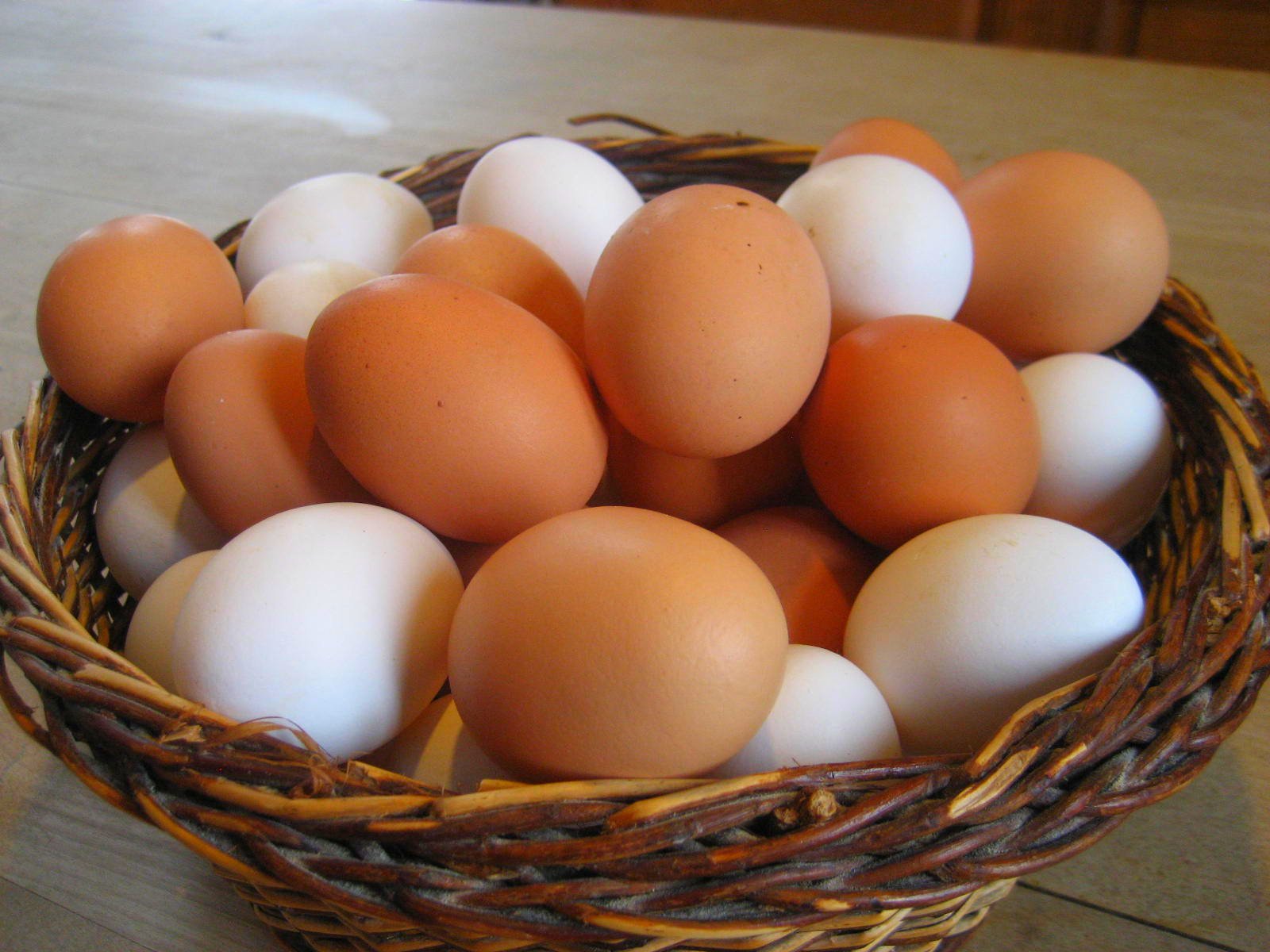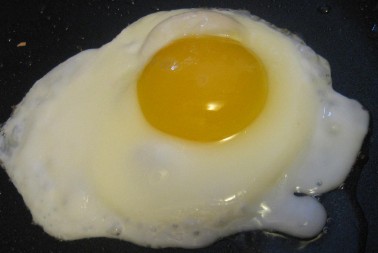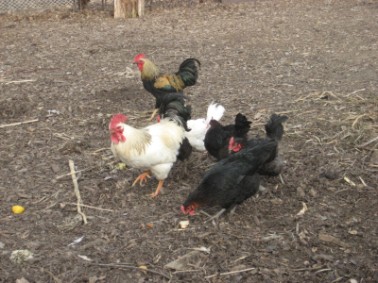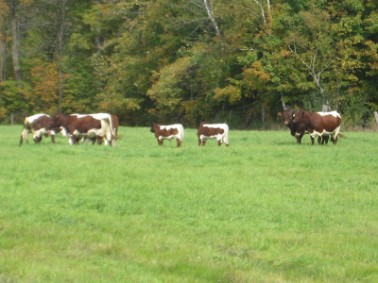FAQ
What is Grass Fed Beef?
Grass fed beef should correctly be called pasture fed beef. Our cattle feeds exclusively what grows on pasture and in the winter hay. Regular (grain fed) beef causes faster growth with more fat and water retention. Grain fed cattle is ready for market in about half the time grass fed beef is. That's why grain fed is cheaper and fatter (marbled).
What is the difference between Grass Fed and Grass Finished Beef?
Many cattle is raised in the first year on pasture, then moved into a finishing area (often sold to a different farm as "stocker") and fed grain until they are shipped to the butcher. This beef is "grass fed (and grain finished)". The cattle gets fattened on the grain diet to obtain the desired "marbling" of fat in the meat. Some cattle gets silage (which is fermented hay or corn). Silage does change the flavour of the meat and milk, if you have a discerning taste.
What about grain-free fed beef?
This is a new variation: In order to get fast weight gain and marbling, some producers now feed potato (it's not a grain right?). Which cow has naturally access to potatoes?
Does Grass Fed Beef taste different?
Many first time clients tell us that they find the grass fed beef tasting a bit different, more "gamey" and firmer. That is true. It has different nutrients and flavours than grain fed, due to the naturally occurring grasses and herbs. It is also very lean and without the fat, you taste more the protein. We don't even put salt on the meat as it has its own flavour.
How is beef being sold? Hanging weight or take-home weight?
When you purchase 20 pounds of grass-fed beef from us,
you receive 20 pounds of frozen meat. We sell by the frozen packaged
weight, individually weighed (the take-home weight).
Often freezer beef is priced "on the rack" or as "hanging weight" and costs much less per pound than the take-home weight. Here's why: Freshly butchered cattle is split in half (after removal of internal organs, head, feet, and skin). This is the warm hanging weight. When the meat cools it loses weight. After 3 weeks of hanging it lost more weight (water evaporates) Then it's cut into portions, trimmed and the bones removed. Then it is packaged and frozen. During freezing the meat loses again some weight. Drying, bones, trimming, freezing loses about 45-55% of the hanging weight. If you purchase meat
by the "dressed or hanging weight", you are paying for approximately 45
to 55% waste, like bones, gristle or unusable parts and water loss that you don't get in the take home weight. ...
Hold on... it gets even more complicated: many producers sell the half cow and ask the customer to pay the butcher cost (which is another $800 or, so per cow). Suddenly your $ 8 per pound hanging weight deal is $15 per pound of take-home weight.
AND don't compare grass fed and grass finished beef with any other beef, because it grows so much slower.
Do you have cooking recommendations for Grass Fed Beef?
Thaw your beef for 2 days in the fridge. If you want to marinate it, plan for at least 6 hours. On the BBQ use the highest heat to grill the beef as fast as possible. Do not overcook it. Cover and let is sit a few minutes after it comes off the BBQ. Then salt it if you like. See here for more
Free range, Free run ... what's the difference?
There are basically three ways of keeping chickens:
A. Indoors in cages: The chickens have a small cage area that they share with other chickens. It's quite crowded in the cages. They sit on a wire bottom that allows the manure to fall through onto a conveyor belt. The barn is climate controlled and the light is regulated maximize laying performance. There are usually three levels of cages on top of each other. This production method requires the least amount of space and allows for the lowest cost eggs - you will get them in the grocery stores
B. Free run: Chickens are roaming indoors only in the barn and have nesting boxes and perches to fly up to. The barn is equally climate and light controlled. The floor is usually slat floor allowing the manure to fall through.
C. Free range: The chickens are allowed to go outside during the day and can eat what they forage outside. They are on the natural daylight cycle. Needless to say that free range chickens have the most space and that this production method is much more expensive than caged eggs.
Efforts are being made in many countries to improve the holding conditions of chickens (enriched housing, aviaries), but it is very difficult, as long as the customers choose food from the cheapest supplier without respect or knowledge how their food was produced. Please inform yourself.
How can you tell whether an eggs is fresh?
Why are some egg yolks darker yellow than others?
It depends very much on the food. In the summer
our chickens eat worms, bugs, grasses, and clover, besides their regular feed. Some foods contain more flavonoids, retinoids and carotenoids, natural pigments that make a very
dark orange yolk. People often associate dark yolk with better nutrition,
however the yolk color is not a good indicator for nutrient contents. Commercial growers add pigments in the chicken food to produce a very standardized
yellow yolk color. Our free range chickens don't have a standardized diet. Therefore some egg yolks are dark and others pale.
In the winter our chickens eat mainly grains,
which have less pigment, therefore the yolk is less dark.
Do your eggs contain Soy or Corn?
This is now a common question. Eggs never contain corn or soy, regardless of what the chickens eat. Eggs neither contain worms, bugs, or grass, although the chickens eat it.
This question is probably been asked by people who have allergies to corn or soy. Let's look at the digestive process to understand what happens to chicken feed before it becomes an egg: All foods contain, among others, proteins. They are large molecules made out of small building blocks called amino acids. I'll give you an example (I know it's a bit silly but it makes the point): Think of a Lego house - that's the large molecule protein, and the Lego blocks are the amino acids. When an animal eats for instance soy protein, the large molecule is digested and chopped up into the small amino acids in the intestines, BEFORE it is even absorbed by the chickens intestines. These individual Lego blocks are then reassembled in the chicken and made into new proteins, like the egg protein, which may look like a space ship instead of the original soy house. If you are allergic to soy protein "house", your body wouldn't be able to tell that the egg protein "space ship" came from soy. The space ship has been built with Lego blocs from any food source. You won't be able to react.
Where can I buy live chickens? Can you take my unwanted chickens?
We
do not sell chickens, chicks, pets. To find some, google for local feed
stores or check kijiji.ca. And we do not take chickens or other
animals. We are not an animal sanctuary. Avian flu is in our area and we
practice a "closed herd" to prevent infections.
Why are we not
certified organic?
Organic certification is quite expensive and
requires a lot of bureaucracy. We did not bother getting certification. We know what we feed and invite you to check us
out. We eat what we produce and only sell what's left over.
Why aren't the eggs
refrigerated?
Our eggs are so fresh
(usually only 0-2 days old) that they don't need refrigeration. They have a natural protein layer on the shell that acts as a bacterial barrier membrane.
Here is a good link explaining the nature of fresh eggs: https://www.facebook.com/pages/York-Region-Environmental-Alliance/108786649195158
How long can eggs
store?
In nature, a female bird (hen, partridge, pheasant
etc.) lays one egg per day into its nest and leaves the eggs at air temperature
until the nest is full. This may take more than a week to complete. Only then
does the bird start incubating the eggs. The eggs are designed to stay easily
fresh for 14 days in any temperature because the egg shell is coated with a
defensive protein barrier inhibiting the penetration of bacteria. Eggs you buy
in the grocery store are all washed and the protein coat removed. They must be
stored in the fridge to preserve their freshness. Store bought eggs can legally be up to 60 days old.
Do chickens lay eggs without a rooster around?
Yes, domesticated chickens lay eggs even if they
never saw a rooster. We however still keep several roosters, because we like
the their wake up call and their patriarchic attitude. Roosters really lead
their “harem” and defend them from intruders. Usually one rooster will have 20
hens in the harem. Ours have larger groups because we don’t need the eggs
fertilized.
Why are some eggs brown and others white?
The color of eggs is determined by the breed of
chicken. White chickens like the Leghorn breed lay only pure white eggs. Brown
or black chickens lay brown eggs. We once had a breed called “Sussex” . They
are basically white but have a few darker feathers around their necks and on
the tail. The egg color was creamy white.
Why are some eggs large and some small?
The size of eggs changes during the lifetime of
the chickens. Young hens start out by laying relatively small eggs. When they
are about 8 months old, they lay full size eggs. That’s why we have sometimes
small eggs. The young ladies just are getting ready for full production. Some
breeds lay larger eggs.
Did you ever wonder why chickens lay eggs in the winter too?
Naturally birds lay their eggs only in the spring/
early summer when the season is optimal to raise the young ones. Chickens have
been domesticated long enough that they forgot this instinct somewhat. However
raising free range chickens, like we do, poses still a problem. Egg production
would decline in the winter… if we wouldn’t trick them a little. Research has
shown that birds determine the right time for laying eggs based on the amount
of daylight hours and not on the weather, temperature, or any other factor.
When the days are getting shorter, they stop laying. That’s why we have light
in our chicken coops to keep the total amount of light constant at 17 hours per
day throughout the year.
Why are you not selling live chickens? I can see them in the runs, can I have one?
The chickens you see year round are laying hens. Their value is that they lay our eggs. We couldn't sell them, because we won't have the eggs from them any longer. And they are skinny and tough to eat. As old soup hens their value is below the butcher cost.
Our meat chickens (which we have once per year) are all being butchered on the same day by a provincially inspected butcher house. You can buy them butchered from
Eggs dry out with aging. Fresh eggs are compact and rise above the pan. Old eggs are flat.



